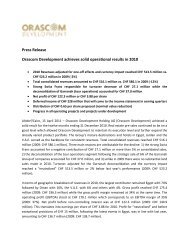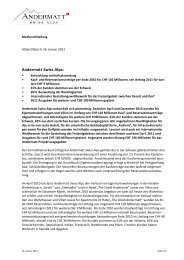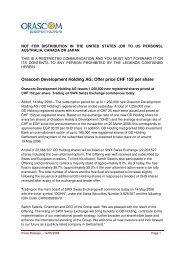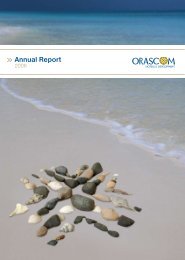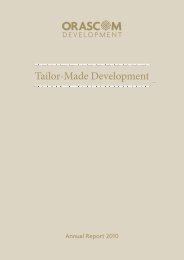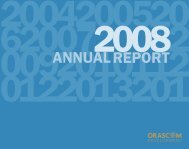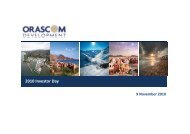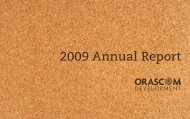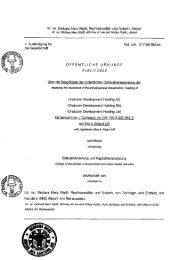FY 2012 Annual Report - Orascom Development
FY 2012 Annual Report - Orascom Development
FY 2012 Annual Report - Orascom Development
You also want an ePaper? Increase the reach of your titles
YUMPU automatically turns print PDFs into web optimized ePapers that Google loves.
F-29 <strong>Orascom</strong> <strong>Development</strong> <strong>2012</strong> <strong>Annual</strong> <strong>Report</strong> F-30<br />
4 CRITICAL ACCOUNTING JUDGMENTS AND KEY SOURCES OF ESTIMATION<br />
UNCERTAINTY<br />
In the application of the Group’s accounting policies, which are described in note 3, management is required to make judgments,<br />
estimates and assumptions about the carrying amounts of assets and liabilities that are not readily apparent from other sources.<br />
The estimates and associated assumptions are based on historical experience and other factors that are considered to be relevant.<br />
Actual results may differ from these estimates.<br />
The estimates and underlying assumptions are reviewed on an ongoing basis. Revisions to accounting estimates are recognised in<br />
the period in which the estimate is revised if the revision affects only that period or in the period of the revision and future periods<br />
if the revision affects both current and future periods.<br />
4.1 Critical judgments in applying accounting policies<br />
The following are the critical judgments, apart from those involving estimations (see note 4.2 below), that management have<br />
made in the process of applying the Group’s accounting policies and that have the most significant effect on the amounts<br />
recognised in the consolidated financial statements.<br />
4.1.1 Revenue recognition – Real estate sales<br />
The operating cycle of residential construction projects predominantly starts when the Group enters into agreements to sell the<br />
real estate units off-plan. The Group treats the sale of real estate units as sale of goods in accordance with IAS 18 Revenue and<br />
IFRIC 15 Agreements for the Construction of Real Estates. Management takes the view that the critical event of revenue<br />
recognition hinges on the transfer of significant risks and rewards of ownership and control to the buyer. When management<br />
makes this assessment it ensures that the detailed criteria for revenue recognition from the sale of goods as set out in IAS 18 and<br />
IFRIC 15 - including the transfer of significant risks and rewards of ownership and control to the buyer - are satisfied and that<br />
recognition of revenue from the sale of real estate is appropriate in the current reporting period.<br />
Given the structure of the real estate sale contracts and the application of IAS 18 and IFRIC 15 as described above, revenue<br />
recognition from residential construction projects can occur in independent stages which consist of the sale of land, constructed,<br />
but unfinished units and finished units. The transfer of significant risks and rewards of ownership and control of each stage is<br />
documented in an official delivery protocol and signed by representatives of the Group as well as the buyer.<br />
Regarding the Acuro deal, which is further explained in note 42, no revenue has been recognized in <strong>2012</strong> due to management’s<br />
assessment that significant risk and rewards will be transferred to the buyer on completion of construction stages and the handing<br />
over of the properties.<br />
4.1.2 Government grants<br />
Acquisition by the Group entities of part of the land used in the construction of their real estate projects from governments of the<br />
local jurisdictions in which they carry out their activities has not brought these transactions under the scope of IAS 20 Accounting<br />
for Government Grants and Disclosure of Government Assistance and, therefore, has not resulted in the recognition of<br />
government grants in the current or in prior periods.<br />
In these cases the government is the only possible seller in the market and the Group purchases the land at market prices available<br />
to all interested parties and does not obtain finance facilities from the government which would require accounting for<br />
government grants.<br />
4.1.3 Employee benefits expense<br />
Employee benefits expense which are directly related to the sale of goods or rendering of services form part of the operation’s cost<br />
of sales. Where employee benefit expense is incurred to perform head quarter functions or relate to non-revenue generating<br />
entities, such as corporate companies, holding companies and start up companies, they are allocated to administration expenses.<br />
4.1.4 Sale of 15% stake in Garranah investments and sale of tour operations<br />
On 1 November <strong>2012</strong>, the Group signed a share sale and purchase agreement to sell to the Garranah family an additional 15%<br />
percent stake in five investments whereof four are operating floating hotels (International Stock Company for Floating Hotels &<br />
Touristic Establishments, Mirotel for Floating Hotels Company, Tarot Garranah & Merotil for Floating Hotels, El Tarek for Nile<br />
Cruises & Floating Hotels) and one is active as a tour operator (Tarot Tours Company (Garranah) SAE). The company that provides<br />
tour transportation services (Tarot Garranah for Touristic Transportation) has been sold completely.<br />
Pursuant to this agreement, the Group’s interest in the four operating floating hotels and the tour operator decreased from 45 to<br />
30 percent however the Group keeps its significant influence over these investments in associates. All interests held in the<br />
company providing tour transportations services have been sold. Legal procedures to transfer title were still in process at year end.<br />
Included in this sale and purchase agreements is also the sale of the residual entity of the Group operation in the tour operations<br />
segment. This sale is disclosed as a discontinued operation in accordance with IFRS 5 in these consolidated financial statements,<br />
as management is of the opinion that being the residual entity of the tour operations segment the sale represents a separate<br />
major line of business. This part of the transaction also included an additional purchase of 8.8% in the subsidiary Royal for<br />
Investments.<br />
4.1.5 Deferred taxation on investment property<br />
For the purposes of measuring deferred tax liabilities or deferred tax assets arising from investment properties management<br />
concluded that the Group’s investment properties are held under a business model whose objective is to consume substantially all<br />
of the economic benefits embodied in the investment properties over time, rather than through sales. Therefore, in determining<br />
the Group’s deferred taxation on investment properties, management has determined that the presumption that the carrying<br />
amounts of investment properties measured using the fair value model are recovered entirely through sale is rebutted. As a result,<br />
the Group has recognised any deferred taxes on changes in fair value of investment properties.<br />
4.2 Key sources of estimation uncertainty<br />
The following are the key assumptions concerning the future and other key sources of estimation uncertainty at the end of the<br />
reporting period, that have a significant risk of causing a material adjustment to the carrying amounts of assets and liabilities<br />
within the next financial year.<br />
4.2.1 Impairment of tangible assets and investments in associates<br />
At the end of each reporting period, the Group reviews the carrying amounts of its tangible assets and investments in associates to<br />
determine whether there is any indication that those assets have suffered an impairment loss.<br />
If any such indication exists, the recoverable amount of the asset is estimated in order to determine the extent of the impairment<br />
loss (if any). Where it is not possible to estimate the recoverable amount of an individual asset, the Group estimates the<br />
recoverable amount of the cash-generating unit to which the asset belongs. Where a reasonable and consistent basis of allocation<br />
can be identified, corporate assets are also allocated to individual cash-generating units, or otherwise, they are allocated to the<br />
smallest Group of cash-generating units for which a reasonable and consistent allocation basis can be identified.<br />
In light of the political development in Egypt, management reconsidered the recoverability of the Group's significant items of<br />
property, plant and equipment and its investments in associates, which are included in the consolidated statement of financial<br />
position at 31 December <strong>2012</strong> at CHF 1,002,981,620 and CHF 18,852,835 respectively (31 December 2011: CHF 969,362,187 and<br />
CHF 29,349,124).<br />
As at 30 June 2o12 the impairment review of investments in associates resulted in an impairment loss of CHF 12.2 million on some<br />
of the investments in Garranah entities. As at 30 September <strong>2012</strong> further indirect impairment of CHF 6.4 million was recognized<br />
through provisions based on the estimated sales price of the 15% stake in Garranah Group subsidiaries. The impairment losses are<br />
shown as other gains and losses (for further details see note 10).<br />
Other than that no other items of property, plant and equipment or investments in associates were impaired. Management is<br />
aware that the slow-down in processes and logistics still impacts the business operations considerably. However, occupancy rates<br />
have started to improve in the last few months and management expects that the slowdown in construction activities mainly leads<br />
to a shift of those revenues to other financial periods. These facts have reconfirmed management's previous estimates of<br />
anticipated revenues from the projects. Management periodically reconsider their assumptions in light of the macroeconomic<br />
developments regarding future anticipated margins on their products. Detailed sensitivity analysis has been carried out and<br />
management is confident that the carrying amount of these assets will be recovered in full, even if returns are reduced. This<br />
situation will be closely monitored, and adjustments made in future periods if future market activity indicates that such<br />
adjustments are appropriate.<br />
4.2.2 Valuation of financial assets at FVTOCI<br />
Basically the fair value of financial assets at FVTOCI is based on stock quotes. However, due to extraordinary situations, as for<br />
example the political situation in Egypt, such market prices might not reflect the real value at all times. In such cases alternative<br />
valuation methods are used to determine the fair value.<br />
4.2.3 Useful lives of property, plant and equipment<br />
The carrying value of the Group's property, plant and equipment at the end of the current reporting period is CHF 1,002,981,620<br />
(31 December 2011: CHF 969,362,187). Management’s assessment of the useful life of property, plant and equipment is based on<br />
the expected use of the assets, the expected physical wear and tear on the assets, technological developments as well as past<br />
experience with comparable assets. A change in the useful life of any asset may have an effect on the amount of depreciation that<br />
is to be recognized in profit or loss for future periods.<br />
Losses on disposal of the 15% stake in Garranah Group entities of CHF 6.4 million were recognized on sale of the 15% stake.<br />
However, as such losses were already recognized as indirect impairment through provisions based on the estimated sales price in<br />
the third quarter of <strong>2012</strong>, they are shown as impairment and not as loss from disposal of part of the investments in associates.<br />
Together with the gains from the sale of the tour transportation services company these losses were recognised through “other<br />
gains and losses” (refer to note 10 for further details).<br />
F-29<br />
F-30



